|
|
Post by Jack on Jul 12, 2008 17:53:46 GMT
Source: NASA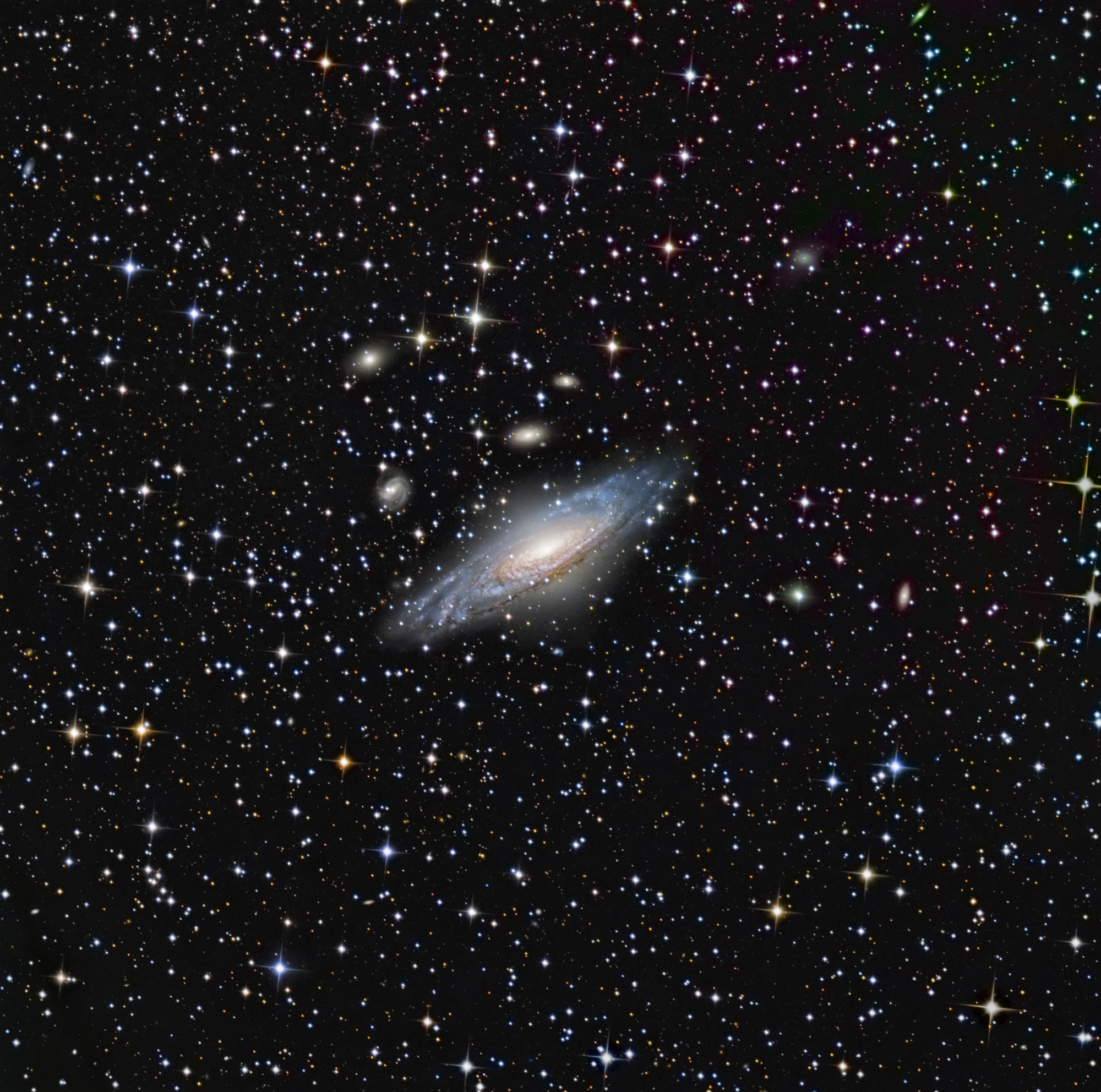 NGC 7331 and Beyond NGC 7331 and Beyond
Credit & Copyright: Don Goldman, Sierra Remote ObservatoriesExplanation: Big, beautiful spiral galaxy NGC 7331 is often touted as an analog to our own Milky Way. About 50 million light-years distant in the northern constellation Pegasus, NGC 7331 was recognized early on as a spiral nebula and is actually one of the brighter galaxies not included in Charles Messier's famous 18th century catalog. Since the galaxy's disk is inclined to our line-of-sight, long telescopic exposures often result in an image that evokes a strong sense of depth. The effect is further enhanced in this well-framed view by the galaxies that lie beyond this gorgeous island universe. The background galaxies are about one tenth the apparent size of NGC 7331 and so lie roughly ten times farther away. Their strikingly close alignment on the sky with NGC 7331 occurs just by chance. The visual grouping of galaxies is also known as the Deer Lick Group.
|
|
|
|
Post by Jack on Jul 13, 2008 19:46:23 GMT
Source: NASA A Dark Sky Over Death Valley A Dark Sky Over Death Valley
Credit: Dan Duriscoe, U.S. National Park ServiceExplanation: This eerie glow over Death Valley is in danger. Scrolling right will show a spectacular view from one of the darkest places left in the continental USA: Death Valley, California. The above 360-degree full-sky panorama is a composite of 30 images taken two years ago in Racetrack Playa. The image has been digitally processed and increasingly stretched at high altitudes to make it rectangular. In the foreground on the image right is an unusually placed rock that was pushed by high winds onto Racetrack Playa after a slick rain. In the background is a majestic night sky, featuring thousands of stars and many constellations. The arch across the middle is the central band of our Milky Way Galaxy. Light pollution is threatening dark skies like this all across the US and the world, and therefore the International Dark-Sky Association and the US National Parks Service are suggesting methods that can protect them.
|
|
|
|
Post by Jack on Jul 16, 2008 16:01:44 GMT
Source: NASA Makemake of the Outer Solar System Makemake of the Outer Solar System
Credit: R. Hurt (SSC-Caltech), JPL-Caltech, NASAExplanation: Recently discovered Makemake is one of the largest objects known in the outer Solar System. Pronounced MAH-kay MAH-kay, this Kuiper belt object is only slightly smaller than Pluto, orbits the Sun only slightly further out than Pluto, and appears only slightly dimmer than Pluto. Makemake, however, has an orbit much more tilted to the ecliptic plane of the planets than Pluto. Designated 2005 FY9 soon after its discovery by a team led by Mike Brown (Caltech) in 2005, the outer Solar System orb was recently renamed Makemake for the creator of humanity in the Rapa Nui mythology of Easter Island. Additionally, Makemake has been recently classified as a dwarf planet under the new subcategory plutoid, making Makemake the third cataloged plutoid after Pluto and Eris. Makemake is known to be a world somewhat red in appearance, with spectra indicating it is likely covered with frozen methane. Since no images of Makemake's surface yet exist, an artist's illustration originally meant to depict Sedna has been boldly co-opted above to now illustrate Makemake. A hypothetical moon is visualized above nearly in the direction of our distant Sun.
|
|
|
|
Post by Jack on Jul 18, 2008 16:27:17 GMT
Source: NASA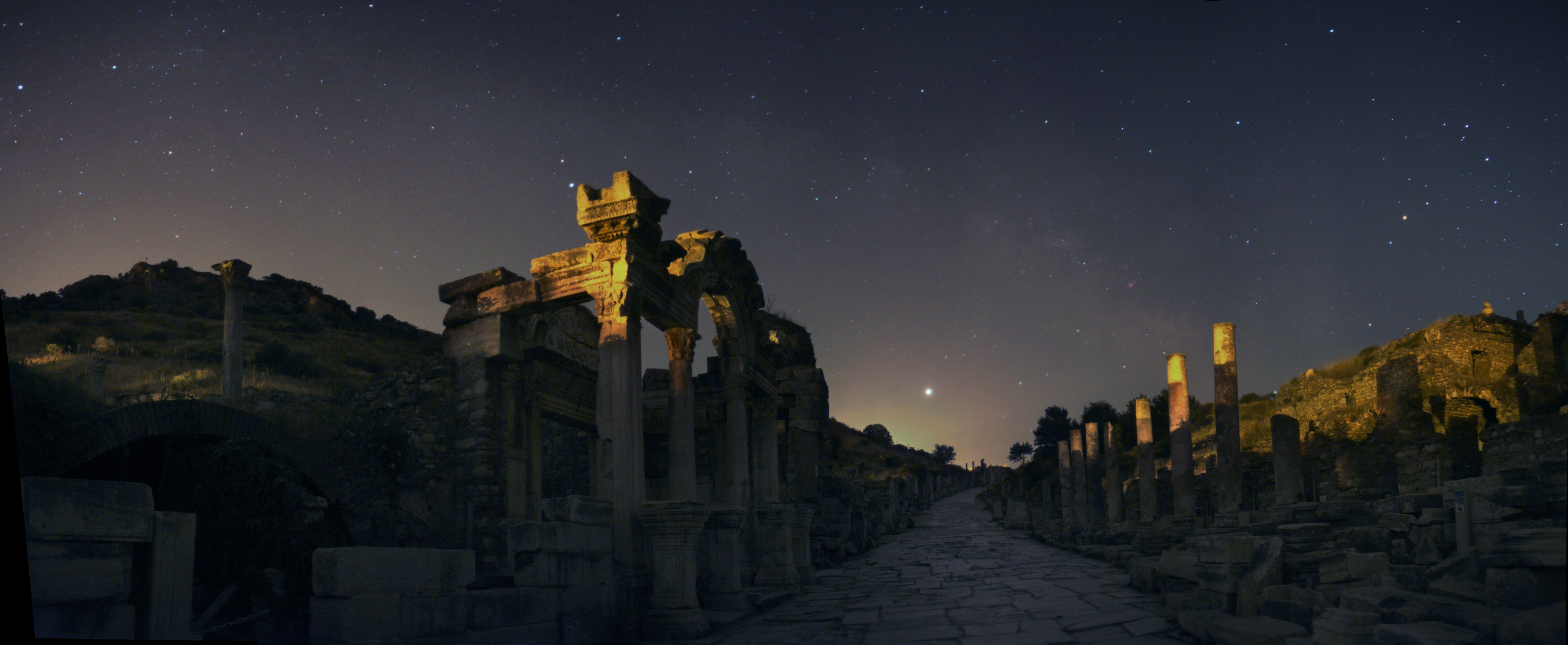 Jupiter over Ephesus Jupiter over Ephesus
Credit & Copyright: Tunç Tezel (TWAN) Explanation: A brilliant Jupiter shares the sky with the Full Moon tonight. Since Jupiter is near opposition, literally opposite the Sun in planet Earth's sky, Jupiter will rise near sunset just like the Full Moon. Of course, opposition is also the point of closest approach, with Jupiter shining at its brightest and offering the best views for skygazers. Recorded late last month, this moving skyscape features Jupiter above the southeastern horizon and the marbled streets of the ancient port city of Ephesus, located in modern day Turkey. At the left is a temple dedicated to the Roman emperor Hadrian. The beautiful night sky also includes the arc of the northern summer Milky Way. Lights on the horizon are from the nearby town of Selçuk. Clicking on the image will download the scene as a panorama.
|
|
|
|
Post by Jack on Jul 19, 2008 14:48:07 GMT
Source: NASA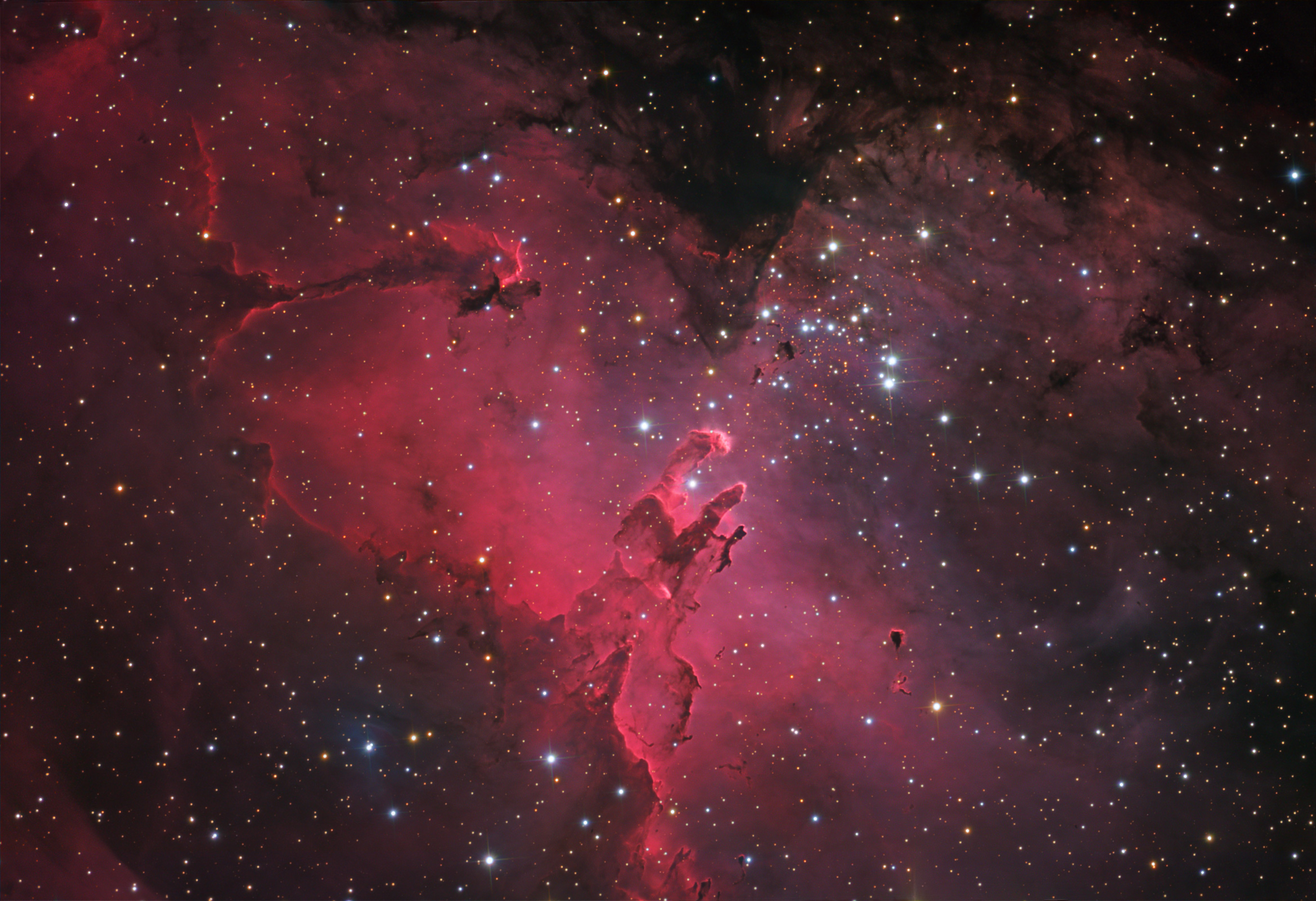 M16 and the Eagle Nebula M16 and the Eagle Nebula
Credit & Copyright: Johannes Schedler (Panther Observatory) Explanation: Young star cluster M16 is surrounded by natal clouds of cosmic dust and glowing gas also known as The Eagle Nebula. This beautifully detailed image of the region includes fantastic shapes made famous in well-known Hubble Space Telescope close-ups of the starforming complex. Described as elephant trunks or Pillars of Creation, dense, dusty columns rising near the center are light-years in length but are gravitationally contracting to form stars. Energetic radiation from the cluster stars erodes material near the tips, eventually exposing the embedded new stars. Extending from the upper left edge of the nebula is another dusty starforming column known as the Fairy of Eagle Nebula. M16 and the Eagle Nebula lie about 7,000 light-years away, an easy target for binoculars or small telescopes in a nebula rich part of the sky toward the split constellation Serpens Cauda (the tail of the snake).
|
|
|
|
Post by Jack on Jul 20, 2008 10:45:14 GMT
Source: NASA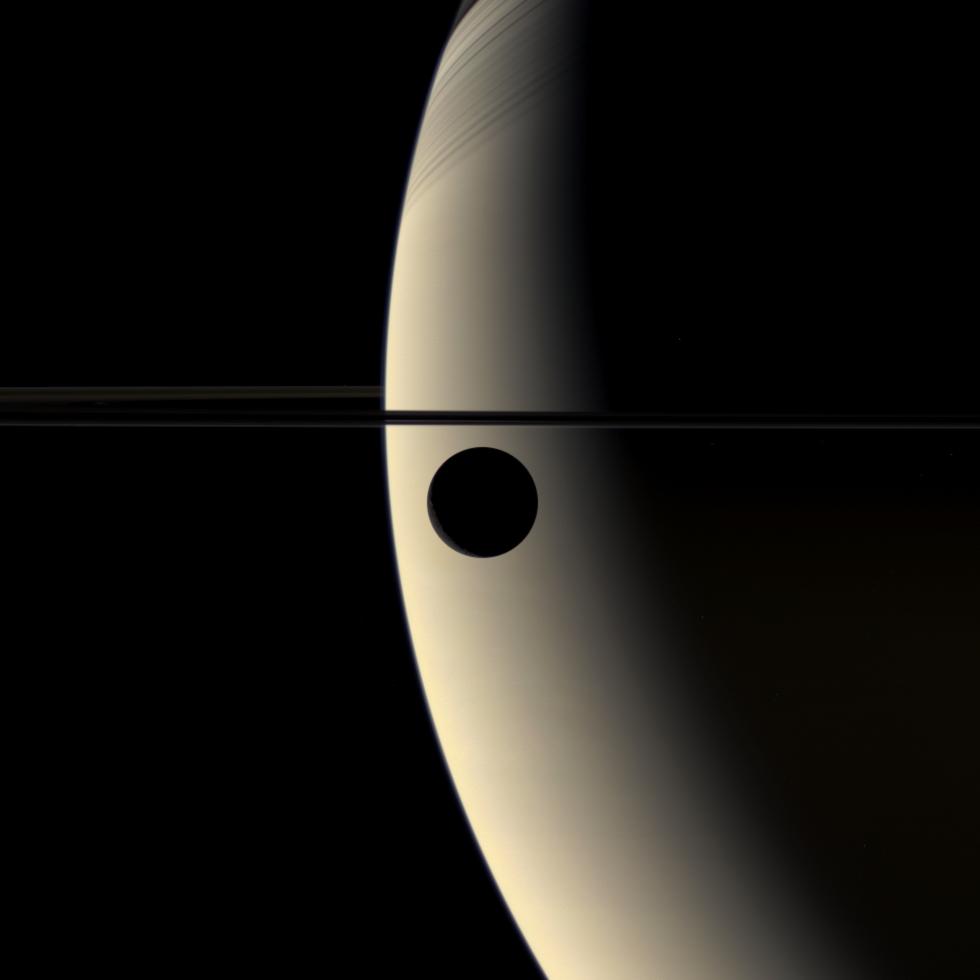 Crescent Rhea Occults Crescent Saturn Crescent Rhea Occults Crescent Saturn
Credit: Cassini Imaging Team, SSI, JPL, ESA, NASAExplanation: Soft hues, partially lit orbs, a thin trace of the ring, and slight shadows highlight this understated view of the majestic surroundings of the giant planet Saturn. Looking nearly back toward the Sun, the robot Cassini spacecraft now orbiting Saturn captured crescent phases of Saturn and its moon Rhea in color a few years ago. As striking as the above image is, it is but a single frame from a recently released 60-frame silent movie where Rhea can be seen gliding in front of its parent world. Since Cassini was nearly in the plane of Saturn's rings, the normally impressive rings are visible here only as a thin line across the image center. Although Cassini has now concluded its primary mission, its past successes and opportunistic location have prompted NASA to start a two-year Equinox Mission, further exploring not only Saturn's enigmatic moons Titan and Enceladus, but Saturn herself as her grand rings tilt right at the Sun in August 2009.
|
|
|
|
Post by Jack on Jul 22, 2008 16:27:41 GMT
Source: NASAExplanation: What are these humans doing? Dancing. Many humans on Earth exhibit periods of happiness, and one method of displaying happiness is dancing. Happiness and dancing transcend political boundaries and occur in practically every human society. Above, Matt Harding traveled through many nations on Earth, started dancing, and filmed the result. The video is perhaps a dramatic example that humans from all over planet Earth feel a common bond as part of a single species. Happiness is frequently contagious -- few people are able to watch the above video without smiling.
|
|
|
|
Post by Jack on Jul 24, 2008 8:34:01 GMT
Source: NASA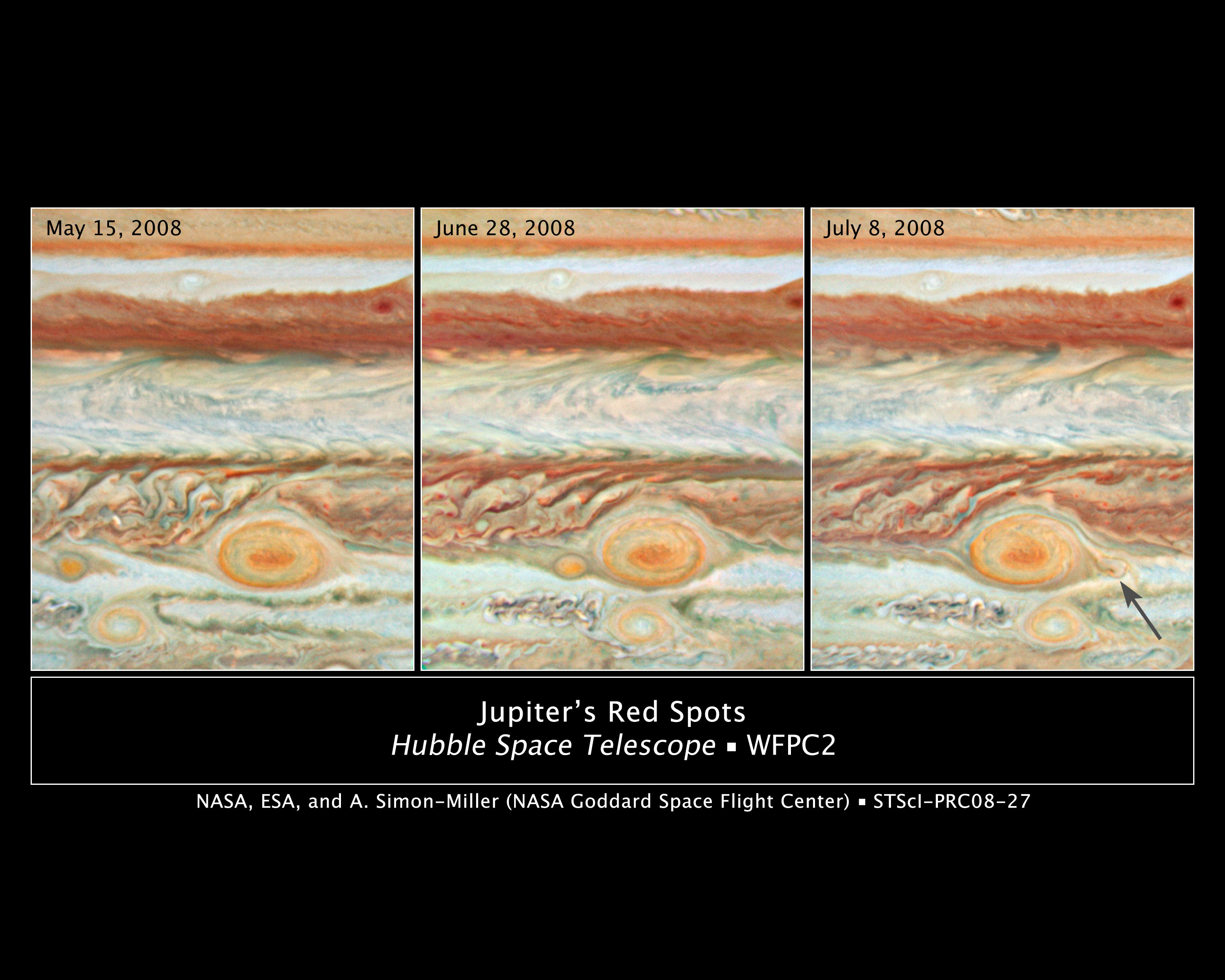 When Storms Collide When Storms Collide
Credit: NASA, ESA, Amy Simon-Miller (Goddard Space Flight Center), N. Chanover (NMSU), G. Orton (JPL) Explanation: These detailed Hubble Space Telescope close-ups feature Jupiter's ancient swirling storm system known as the Great Red Spot. They also follow the progress of two newer storm systems that have grown to take on a similar reddish hue: the smaller "Red Spot Jr." (bottom), and smaller still, a "baby red spot". Red Spot Jr. was seen to form in 2006, while the smaller spot was just identified earlier this year. For scale, the Great Red Spot has almost twice the diameter of planet Earth. Moving horizontally from left to right past the Great Red Spot, Red Spot Jr. clearly went below the larger storm, but the smaller spot was pulled in. Emerging on the right, the baby spot's stretched and now paler shape is indicated by the arrow in the frame from July 8. It is expected that the baby red spot will be pulled back and merge, becoming part of the giant storm system.
|
|
|
|
Post by Jack on Jul 27, 2008 12:17:23 GMT
Source: NASA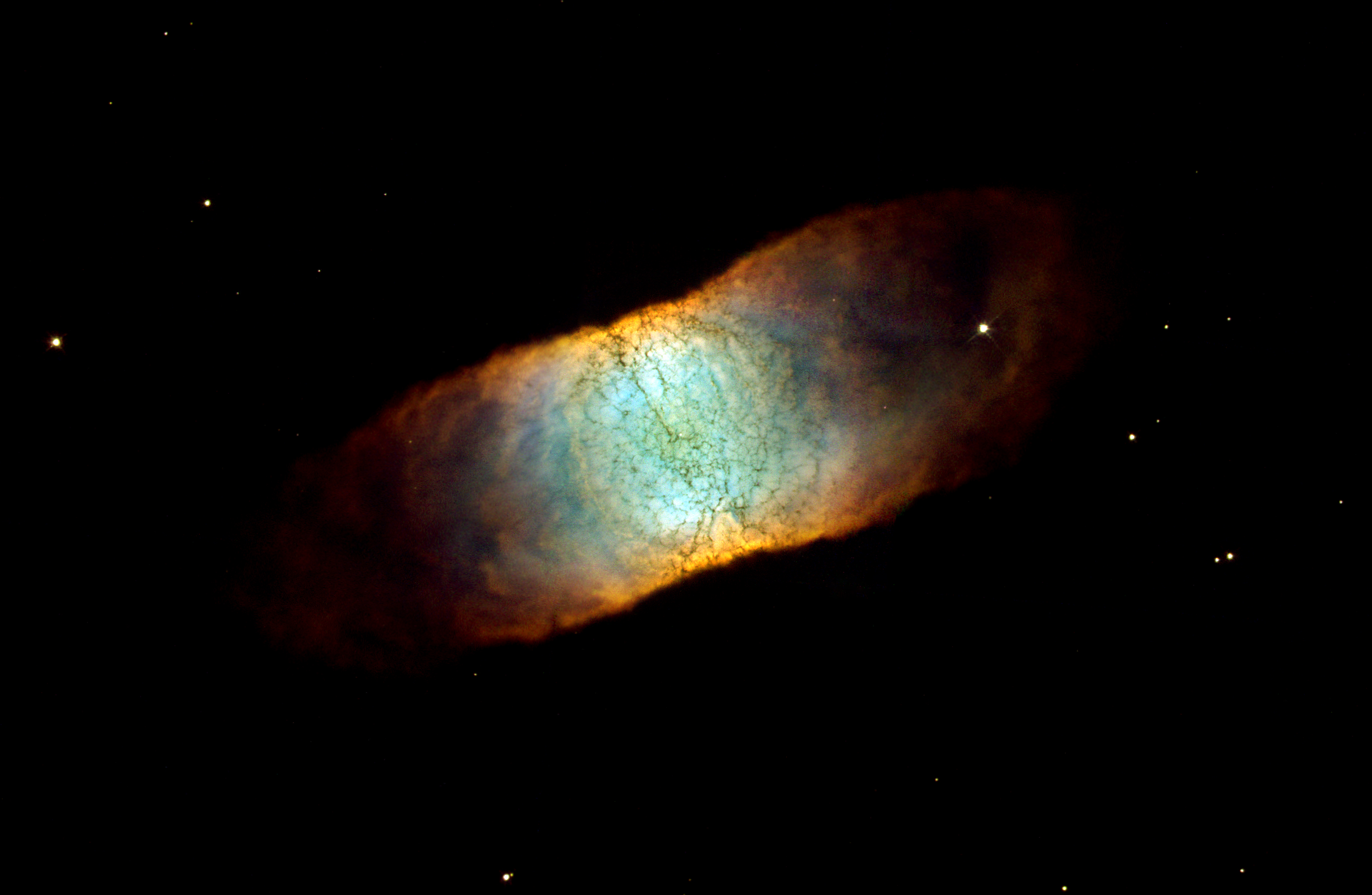 IC 4406: A Seemingly Square Nebula IC 4406: A Seemingly Square Nebula
Credit: C. R. O'Dell (Vanderbilt U.) et al., Hubble Heritage Team, NASAExplanation: How can a round star make a square nebula? This conundrum comes to light when studying planetary nebulae like IC 4406. Evidence indicates that IC 4406 is likely a hollow cylinder, with its square appearance the result of our vantage point in viewing the cylinder from the side. Were IC 4406 viewed from the top, it would likely look similar to the Ring Nebula. This representative-color picture is a composite made by combining images taken by the Hubble Space Telescope in 2001 and 2002. Hot gas flows out the ends of the cylinder, while filaments of dark dust and molecular gas lace the bounding walls. The star primarily responsible for this interstellar sculpture can be found in the planetary nebula's center. In a few million years, the only thing left visible in IC 4406 will be a fading white dwarf star.
|
|
|
|
Post by Jack on Jul 30, 2008 16:42:18 GMT
Source: NASA The International Space Station Transits the Sun The International Space Station Transits the Sun
Credit & Copyright: Martin WagnerExplanation: That's no sunspot. It's the International Space Station (ISS) caught by chance passing in front of the Sun. Sunspots, individually, have a dark central umbra, a lighter surrounding penumbra, and no solar panels. By contrast, the ISS is a complex and multi-spired mechanism, one of the largest and most sophisticated machines ever created by humanity. Also, sunspots occur on the Sun, whereas the ISS orbits the Earth. Transiting the Sun is not very unusual for the ISS, which orbits the Earth about every 90 minutes, but getting one's timing and equipment just right for a great image is rare. Strangely, besides that fake spot, the Sun, last week, lacked any real sunspots. Sunspots have been rare on the Sun since the dawn of the current Solar Minimum, a period of low solar activity. Although fewer sunspots have been recorded during this Solar Minimum than for many previous decades, the low solar activity is not, as yet, very unusual.
|
|
|
|
Post by Jack on Aug 2, 2008 9:34:22 GMT
Source: NASA Eclipse Shirt Eclipse Shirt
Credit & Copyright: Philippe HaakeExplanation: Of course, everyone is concerned about what to wear to a solar eclipse. No need to worry though, nature often conspires to project images of the eclipse so that stylish and appropriate patterns adorn many visible surfaces - including clothing - at just the right time. Most commonly, small gaps between leaves on trees can act as pinhole cameras and generate multiple recognizable images of the eclipse. In Madrid to view the 2005 October 3rd annular eclipse of the Sun, astronomer Philippe Haake met a friend who had another inspiration. The result, a grid of small holes in a kitchen strainer produced this pattern of images on an 'eclipse shirt'. While Yesterday's solar eclipse was total only along a narrow path beginning in northern Canada, extending across the Arctic, and ending in China, a partial eclipse could be seen from much of Europe and Asia.
|
|